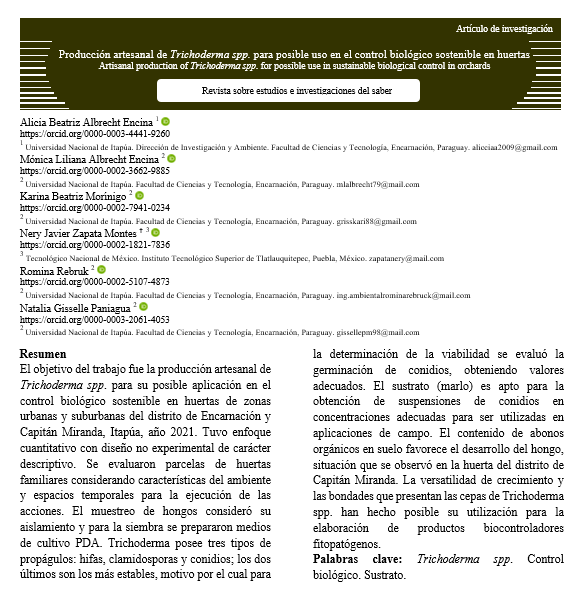Artisanal production of Trichoderma spp. for possible use in sustainable biological control in orchards
DOI:
https://doi.org/10.70833/rseisa17item255Keywords:
Trichoderma spp, Biological control, SubstrateAbstract
The objective of the study was the artisanal production of Trichoderma spp. for its potential application in sustainable biological control in urban and sub-urban gardens in the district of Encarnación and Capitán Miranda, Itapúa during the year 2021. The descriptive study developed a quantitative approach with a non-experimental. Local people garden plots were evaluated considering characteristics of the environment and temporary spaces for the execution of the actions. The sampling of fungi was considered for the isolation and PDA culture media were prepared for sowing. Trichoderma has three types of propagules: hyphae, chlamydospores and conidia; the last two are the most stable, which is why conidia germination was evaluated to determine viability, obtaining satisfactory values. The substrate is suitable to generate suspensions of conidia in acceptable concentrations to be used in field applications. The content of organic fertilizers in soil favors the development of the fungus, a condition that was observed in the gardens of the district of Capitán Miranda. The versatility of growth and the benefits that the strains of Trichoderma spp. have made promising its use to make phytopathogenic biocontrol products.
Downloads
References
Affokpon, A., Coyne, D. L., Htay, C. C., Agbèdè, R. D., Lawouin, L., & Coosemans, J. (2011). Biocontrol potential of native Trichoderma isolates against rootknot nematodes in West African vegetable production systems.
Agamez, E., Zapata, R., Oviedo, L., & Barrera, J. (2008). Evaluación de sustratos y procesos de fermentación sólida para la producción de esporas de Trichoderma sp. Revista Colombiana de Biotecnología, 23-34. Retrieved from https://www.redalyc.org/pdf/776/77610204.pdf
Albrecht, A. (2019). Diversidad Micológica del cultivo de Chía (Salvia hispánica L) en fincas rurales de Itapúa y Misiones, Paraguay. Encarnación.
Ávila, F., Molina, L., & Garcés, F. (2017). Trichoderma harzianum en pre-transplante aumenta el potencial agronómico del cultivo de piña. Revista Brasileira de Ciências Agrárias, 411 - 414.
Benites, C., & Marroquín, L. (2013). Producción de Trichoderma Harzianum en diferentes sustratos. Revista Portal de la Ciencia, 68-74.
Bulluck III, L., Brosius, M., Evanylo, G., & Ristaino, J. B. (2002). Organic and synthetic fertility amendments influence soil microbial, physical and chemical properties on organic and conventional farms. Applied Soil Ecology, 147-160.
Cañedo, V., & Ames, T. (2004). Manual de laboratorio para el manejo de hongos entomopatógenos. Lima: Centro Internacional de la Papa (CIP).
Castellano, G., Jara, C., & Mosquera, G. (2011). Guías de prácticas de laboratorio para el manejo de patógenos del frijol. Centro Internacional de Agricultura Tropical (CIAT). 7-8.
Cooney, J., Lauren, D., Jensen, D., & Perry-Meyer, L. (1997). Effect of solid substrate, liquid supplement, and harvest time on 6–n–pentyl–2h–pyran–2–one (6PAP) production by Trichoderma spp. . Journal of Agriculture and Food Chemistry, 531-534.
Covacevich, F., & Consolo, F. (2014). Herramientas para el estudio y manipulación de Hongos Micorrícicos Arbusculares y Trichoderma.
Dirección de Meteorología e Hidrología. (2020). Boletín de Perspectivas Climáticas .
Flores, E., Huanca, G., Onofre, X., Jiménez, P., Torrez, M., Guarachi, H., . . . Fernández, C. (2018). Producción de Trichoderma spp, en diferentes sustratos. Revista Estudiantil AGRO - VET, 220-224. Retrieved from http://www.ojs.agro.umsa.bo/index.php/AGV/article/view/308/298
García, R., Riera, R., Zambrano, C., & Gutiérrez, L. (2006). Desarrollo de un fungicida biológico a base de una cepa del hongo Trichoderma harzianum proveniente de la región andina venezolana. Fitosanidad, 115-121. Retrieved from https://www.redalyc.org/pdf/2091/209116102005.pdf
Gilchrist, G., Fuentes, G., Martinez, C., Lopez, R. D., Singh, R., Henry, M., & García, I. (2005). Guía práctica para la identificación de algunas enfermedades de trigo y cebada.
González, M., Castellanos, G., Ramos, F., & Pérez, G. (2005). Efectividad de Trichoderma spp. para el control de hongos patógenos de la semilla y el suelo en el cultivo del fríjol. Fitosanidad.
Jiménez, P. E., & Pantoja, V. E. (2012). Diseño y contrucción de un fermentador rotatorio de fase sólida para la multiplicación del hongo Trichoderma sp. Riobamba.
López, M., Ros, A., J., & P. (2011). Mycoparasitism-related genes expression of Trichoderma harzianum isolates to evaluate their efficacy as biological control agent. Biological Control, 59-66.
Martínez, B., Infante, D., & Reyes, Y. (2013). Trichoderma spp. y su función en el control de plagas en los cultivos. Revista Protección Vegetal, 1-11.
Michel, A., Otero, M., Martínez, R., Rodríguez, N., Ariza, R., & Barrios, A. (2008). Producción Masiva de Trichoderma harzianum Rifai en diferentes sustratos orgánicos. REVISTA CHAPINGO SERIE HORTICULTURA, vol. 14 - ISSN: 1027-152X, 185-191.
Navazollah, S., & Navid, H. (2008). Control biológico del nematodo agallador Meloidogyne javanica por Trichoderma harzianum.
Norte, A. (2007). “Trichoderma”. Revista digital SpainsBonsai.com.
Nugra Sánchez, A. N. (2018). Evaluación de sustratos de orgánicos para la propagación del Trichoderma spp. Quito.
Pineda, J., Benavides, E., Duarte, A., Burgos, C., Soto, C., Pineda, C., . . . Álvarez, S. (2017). Producción de biopreparados de Trichoderma spp: una revisión. ICIDCA. Sobre los Derivados de la Caña de Azúcar, 47-52.
MK
Pocasangre, L., Donaldo, M., Zum, F. A., Riversos, A., Rosales, F., & Sikora, R. (2006). Hongos endofíticos como agentes biológicos de control de fitonematodos en banano. XVII Reuniao Internacional de Associaçao para a Cooperaçaonas Pesquisas sobre banano no Caribe na América Tropical.
Quiñónez Vera , L. R. (2019). Dinámica de Fósforo bajo diferentes sistemas de manejo de suelo. San Lorenzo.
Sandoval, M. C., & Belesansky, C. (2020). Producción artesanal del hongo antagónico Trichoderma Persoon en sustrato sólido. Revista de Divulgación Técnica Agropecuaria, Agroindustrial y Ambiental, 55-64.
Sivila, N., & Susana, A. (2013). Producción Artesanal de Trichoderma. Universidad de Jujuy, 10-45. Retrieved from https://www.academia.edu/download/36914956/Manual_de_Trichoderma_2013_CEDAF_Jujuy.pdf
Valdés, E. (2014). Caracteres principales, ventajas y beneficios agrícolas que aporta el uso de Trichodermacomo control biológico. Agroecosistemas, 254-264. Retrieved from https://aes.ucf.edu.cu/index.php/aes/article/view/40
Vargas, H., & Gilchrist, E. (2015). Biodisponibilidad de Trichoderma asperellumen el tiempo en suelo Andisol en condiciones de laboratorio y campo. Revista Lasallista de investigación, 72-80.
Vásquez, J. (2010). Caracterización microbiológica y producción de Trichoderma Harzianum y Trichoderma Viride en cultivo artesanal - Tesis. Bogotá, D.C.: Pontificia Universidad Javeriana.

Downloads
Published
How to Cite
License
Copyright (c) 2023 Alicia Beatriz Albrecht Encina, Mónica Liliana Albrecht Encina , Karina Beatriz Morínigo, Nery Zapata, Romina Rebruk , Natalia Gisselle Paniagua

This work is licensed under a Creative Commons Attribution 4.0 International License.
Creative Commons Attribution License CC-BY
You are free to:
Share — copy and redistribute the material in any medium or format.
Adapt — remix, transform, and build upon the material for any purpose, including commercially.
Under the following terms:
Attribution — You must give appropriate credit, provide a link to the license, and indicate if any changes have been made. You may do so in any reasonable way, but not in any way that suggests that you or your use is endorsed by the Licensor.






